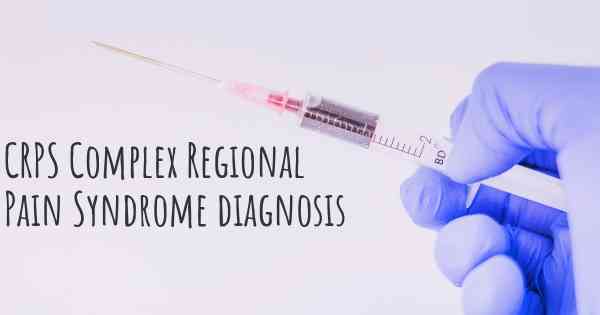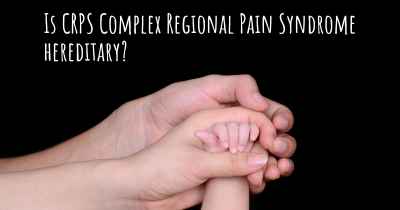4
How is CRPS Complex Regional Pain Syndrome diagnosed?
See how CRPS Complex Regional Pain Syndrome is diagnosed. Which specialists are essential to meet, what tests are needed and other useful information for the diagnosis of CRPS Complex Regional Pain Syndrome

Well it's diagnosed based on what you tell the doctor. With me I had a broken growth plate, but I was told for 8 months it was a sprain. After that I saw someone else and he said it was CRPS so usually it just takes a while.
Posted Apr 20, 2017 by Chloe 1000
There is no good way to diagnose CRPS. The tests they give can often be painful and don't tell the whole story. The best physician to see is an Anesthesiologist or Neurologist. I had two nerve conduction studies performed that where very, very painful that showed I was having slowing and abnormal nerve speeds. I would not wish this test upon anyone who has CRPS. Bone Scan is another test that can be done. Other times X-rays can show CRPS related bone loss.
Honestly, the best test is temperature tests from one limb to the other. Anything over 1/2 °C change along with a history of other symptoms is a good indicator. For example my affected foot was 5 °C colder than my other foot. that's almost 10° F difference. Very painful.
Honestly, the best test is temperature tests from one limb to the other. Anything over 1/2 °C change along with a history of other symptoms is a good indicator. For example my affected foot was 5 °C colder than my other foot. that's almost 10° F difference. Very painful.
Posted May 9, 2017 by Jon 1100
There is no definitive diagnostic test to confirm crps. It is diagnosed by inproportionate pain levels compared to the initial injury, if there was one. Also it is diagnosed by elimination of other diseases that match the symptoms till all options are eliminated. It is a hard diagnosis to get to and many still suffer with crps but have been misdiagnosed as it is a very complex disease, hence the name complex regional pain syndrome. The best thing to do to get to a diagnosis is be persistent in your care and in the search for answers, even if you end up seeing several doctors. If you think you may have crps, look for a doctor that specializes in crps.
Posted May 24, 2017 by Vicki 500
By a pain management doctor that is familiar with the disease
Posted May 24, 2017 by Stevi 600
Before being diagnosed, I went through the process of elimination for everything else: nerve conduction study, bone scan, rheumatology tests, PT, OT, you name it. There are no tests "for" CRPS. It really just comes after you've eliminated all other possibilities
Posted May 28, 2017 by Amy 500
CRPS is extremely difficult to diagnose. You really have to test for everything else until you're left with CRPS
Posted Aug 17, 2017 by Chelsea 2335
Often sets in after surgery. There are neurological tests that can be carried out but are not specific and CRPS has no set test. Any pain that continues for longer than 6 months is chronic
Posted Sep 6, 2017 by [email protected] 5060
For me it was mostly the symptoms I had. But also had EMG, therm-graph, bone density.
Posted Sep 11, 2017 by Craig 1600
For me diagnosis was very slow as it can only really be diagnosed by eliminating every other possibility. Yes there is pain, swelling, color, lack of mobility and sensation too but various things can produce some or all of the above.
Posted Sep 13, 2017 by Andy 3550
CRPS is one of those diseases that depends on ruling out other conditions and then meeting certain criteria before a diagnosis is given. Most pain management doctors utilize the Budapest criteria for diagnosing CRPS:
1. Continuing pain, which is disproportionate to any inciting event
2. Must report at least one symptom in three of the four following categories:
A. Sensory: reports of hyperesthesia and/or allodynia
B. Vasomotor: reports of temperature asymmetry and/or skin color changes and/or skin color asymmetry
C. Sudomotor/edema: reports of edema and/or sweating changes and/or sweating asymmetry
D. Motor/trophic: reports of decreased range of motion and/or motor dysfunction (weakness, tremor, dystonia) and/or trophic changes (hair, nail, skin)
3. Must display at least one sign at time of evaluation in two or more of the following categories:
A. Sensory: evidence of hyperalgesia (to pinprick) and/or allodynia (to light touch and/or deep somatic pressure and/or joint movement)
B. Vasomotor: evidence of temperature asymmetry and/or skin color changes and/or asymmetry
C. Sudomotor/edema: evidence of edema and/or sweating changes and/or sweating asymmetry
D. Motor/trophic: evidence of decreased range of motion and/or motor dysfunction (weakness, tremor, dystonia) and/or trophic changes (hair, nail, skin)
4. There is no other diagnosis that better explains the signs and symptoms
1. Continuing pain, which is disproportionate to any inciting event
2. Must report at least one symptom in three of the four following categories:
A. Sensory: reports of hyperesthesia and/or allodynia
B. Vasomotor: reports of temperature asymmetry and/or skin color changes and/or skin color asymmetry
C. Sudomotor/edema: reports of edema and/or sweating changes and/or sweating asymmetry
D. Motor/trophic: reports of decreased range of motion and/or motor dysfunction (weakness, tremor, dystonia) and/or trophic changes (hair, nail, skin)
3. Must display at least one sign at time of evaluation in two or more of the following categories:
A. Sensory: evidence of hyperalgesia (to pinprick) and/or allodynia (to light touch and/or deep somatic pressure and/or joint movement)
B. Vasomotor: evidence of temperature asymmetry and/or skin color changes and/or asymmetry
C. Sudomotor/edema: evidence of edema and/or sweating changes and/or sweating asymmetry
D. Motor/trophic: evidence of decreased range of motion and/or motor dysfunction (weakness, tremor, dystonia) and/or trophic changes (hair, nail, skin)
4. There is no other diagnosis that better explains the signs and symptoms
Posted Sep 15, 2017 by DrLisa 3750
Pain specialist and neurologists
Posted Sep 19, 2017 by Alex 2550
This is the most difficult part of this disease. There is no test that states you have CRPS. It is diagnosed normally after an injury that doesn't heal. It can take a long time to diagnos for this reason and if diagnosed sooner a person could actually go into remission. Individuals that have an injury that should have healed and hasn't should consult with a pain clinic immediately. Most now are aware of this disease. Many neurologists are also.
Posted Oct 8, 2017 by Valerie 1500
Your doctor will diagnose it. It can be diagnosed by looking and listening to your symptoms. There is no diagnostic test that can diagnose crps Type 1 or 2. There are tests to confirm nerve damage for Type 2
Posted Nov 11, 2017 by Robbie 2000
Bone scans are helpful, I was seen by pain management doctors for evaluation by my PCP and was diagnosed after she looked . EMGs are often suggested , often times not performed due to the possibly of CRPS and the dangers of spreading. X-rays don’t show the disease . A neurologist is a great teammate, pain management doctor, physical therapist is key.
Posted Nov 11, 2017 by Aj 2000
Through a medical history and ruling out tests. MRI and an EGG.
Posted Nov 12, 2017 by Shanna 5000
I believe it is diagnosed based on symptoms. I would suggest that a patient see a doctor who specializes in CRPS, a pain management doctor and a physical therapist.
For diagnosis the doctor needs to have a complete history of the patient and their injury as well as their symptoms.
For diagnosis the doctor needs to have a complete history of the patient and their injury as well as their symptoms.
Posted Nov 12, 2017 by ladyff1481 2050
In my case, I saw a neurologist, rheumatologist, and six orthopedic surgeons. It was the orthopedic surgeons who asked the right questions and who were the most observant as they specialize in joints. My injury started after a violent hit to my right elbow.
So, see an orthopedic surgeon if you don't want to waste time. But ask to see a neurologist for an EMG to determine type 1 or 2. Mine is type 2 -- nerve damage indicated.
So, see an orthopedic surgeon if you don't want to waste time. But ask to see a neurologist for an EMG to determine type 1 or 2. Mine is type 2 -- nerve damage indicated.
Posted Nov 13, 2017 by Thea 3150
The Budapest criteria, interdisciplinary work, multimodal pain therapy, pain therapist, neurologist, orthopedic, QST
Posted May 30, 2018 by Passwort123 700
Temperature of skin, color of infected area, swelling and sensitivity.
Posted May 31, 2018 by Marcia 500
By using the Buda Pest Criteria ie, Signs that are visible.
Posted Oct 25, 2018 by Misty 2100
In the case of a fracture, I believe the Orthopedist should be able to diagnose it. When the symptoms are severe (like mine), they should be capable to recognize the telltale signs. Abnormal swelling, purple/blue claw like hand shape, horrific pain, lack of mobility beyond fracture site, etc. The sooner the diagnosis the better. Then on to nerve blocks. I saw a Neurologist, Rheumatologist, Physiologist etc....
Posted Nov 1, 2018 by Judy 3000
Usually, a Neurologist will diagnose the CRPS by depending on the location of CRPS some have Ganglion Blocks done along with MRIs and EMG test. To make sure it is not some other disease that is simular.
Posted Jan 5, 2019 by Cynthia 4000
Nerve conduction tests
Nerve blocks (injection)
Sometime blood work
All is to rule out anything else mainly
Nerve blocks (injection)
Sometime blood work
All is to rule out anything else mainly
Posted Jan 16, 2021 by Patricia 3050
You need to get and MRI and X-Ray done to rule out any breaks or fractures. Then you need to see a neurologist. After your diagnoses, you may need to see a pain specialist or physical therapist to seek additional care.
Posted Mar 29, 2021 by Sage0920 2000
Exclusionary tests tor rule out others such as Multiple Scleroris, Fibromyalgia et al.
Posted Nov 3, 2022 by Heather 5020








